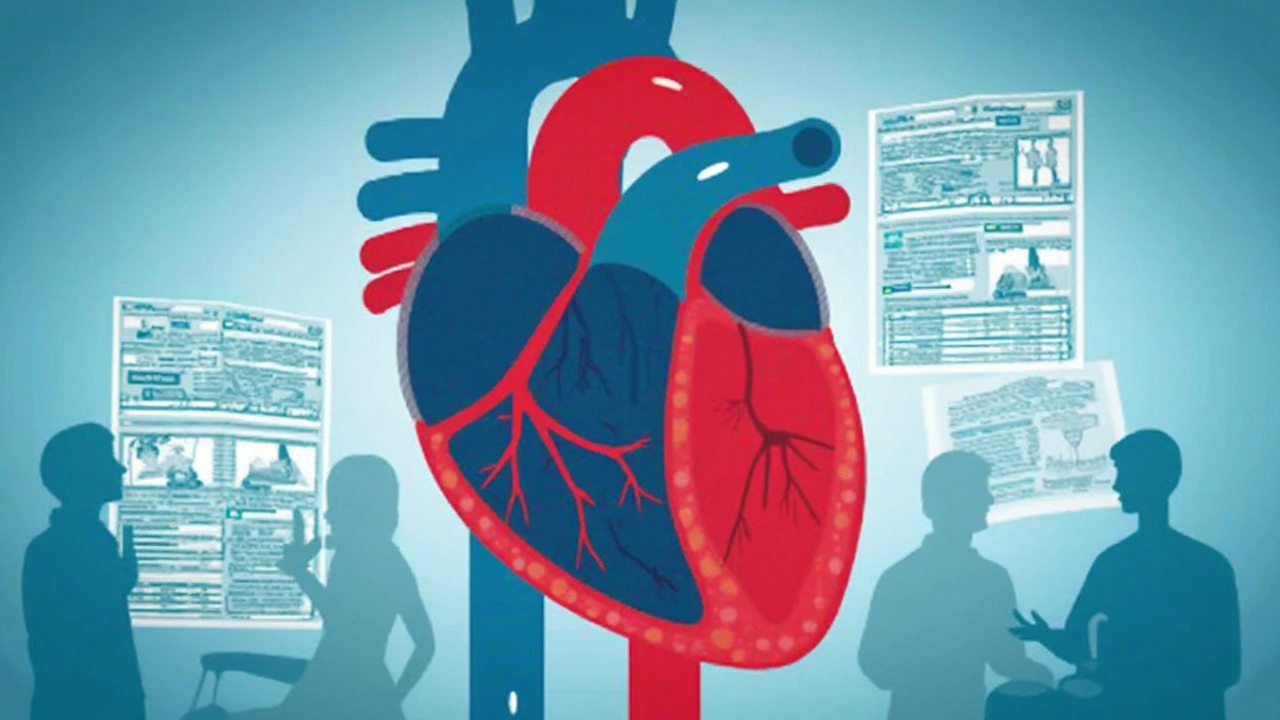Life can throw curveballs, but nothing knocks a person off their feet faster than hearing the words "high blood pressure." Suddenly, daily choices matter a lot more, from what you eat to how much you move. That’s where Diovan enters the scene. Maybe you’ve seen that name on a relative’s prescription bottle, or maybe your doctor just mentioned valsartan—yep, same thing. But what makes Diovan so special compared to other medicines in the crowded world of blood pressure pills?
What Is Diovan and How Does It Work?
Diovan is the brand name for valsartan, a medication that's been holding its own since the late 1990s. It belongs to a group called ARBs, or angiotensin II receptor blockers. The main job here is to block a hormone that tightens up your blood vessels. Think of it like turning a tight hose back to its normal size—blood flows easier, your heart relaxes, and your blood pressure drops. Suddenly, your body has a little more breathing room, literally.
Doctors reach for Diovan when patients have high blood pressure (hypertension), heart failure, or have had a recent heart attack. Around one in three adults in the U.S. deals with high blood pressure, which means millions are walking that tightrope every single day. If left alone, high blood pressure chews away at organs over years or even decades. Diovan’s job is to interrupt this slow, quiet destruction.
This medication is not just about numbers on a blood pressure cuff. When it knocks down high blood pressure, it reduces your risk for serious stuff like strokes, kidney damage, and even vision loss. The American Heart Association lists valsartan as one of its first-line picks, especially for people who can’t handle the nagging dry cough that sometimes comes with another big class of drugs—ACE inhibitors.
Quick science detour: Diovan doesn’t act right away. This isn’t an “emergency” fix for sky-high readings. Usually, you’ll see the full effect after one or two weeks of regular use. Patience is key!
Who Needs Diovan and What Conditions Does It Treat?
If there were a club for "hearts under stress," members would probably get a starter pack that included Diovan. This drug has three main targets: high blood pressure, heart failure, and sometimes people recovering from a heart attack.
Here’s a quick peek at how it fits in each case:
- High Blood Pressure: That’s the classic use. Most people get started when their numbers creep above 130/80 mmHg. Diovan doesn’t cure hypertension, but it makes managing it a heck of a lot easier. Plus, for folks who freak out about side effects, valsartan tends to be gentler compared to similar drugs.
- Heart Failure: This isn’t about having a heart attack—it’s when the heart is just struggling to pump the way it should. Diovan helps ease the load on a tired heart and improve how you feel day-to-day.
- Post-Heart Attack: If your heart muscle got damaged, Diovan protects what’s left, keeps blood vessels open, and lowers the chances of another big, scary event.
There’s one more off-the-beaten-track use. Doctors sometimes prescribe Diovan to help prevent kidney problems in people with diabetes, especially if they already show tiny signs of kidney strain. Why risk it? High blood pressure is brutal on the kidneys, and this drug puts up a pretty good defense.
But it’s not for everyone. Children under six aren’t usually given valsartan, and women who are pregnant (or planning to be!) need to skip this medication. It’s been shown to cause harm to unborn babies, hard stop. If any woman taking Diovan even thinks she might be pregnant, the advice is always the same: contact the doctor, pronto.
For the most up-to-date, granular info, let’s break down Diovan and its use by age and condition:
| Condition | Recommended Age Group | Common Dosage (Adults) | Special Considerations |
|---|---|---|---|
| Hypertension | 6 years & older | 80-320 mg/day | Monitor kidney/liver function |
| Heart Failure | Adults only | Starting at 40 mg twice daily, can increase | Watch potassium levels |
| Post-Heart Attack | Adults only | Starting at 20 mg twice daily, titrate up | Monitor vital signs regularly |
Doctors adjust the dose depending on how your body reacts, and sometimes it takes a few tries to land on the perfect amount. Don’t expect instant magic, but stick with your regimen and keep up with checkups—you’ll usually see results that last.

Benefits of Diovan: More Than Just a Number
Most folks think medicine like this is just about tamping down high blood pressure, but the bonus perks are pretty surprising. For starters, Diovan has less of those weird side effects that crop up with older meds. Have you heard someone complain about a persistent dry cough with other blood pressure pills? That’s usually from ACE inhibitors. With valsartan, that’s a lot less common, and people often find it easier to stick with long-term.
Live with diabetes and high blood pressure? Diovan can shield your kidneys from damage by slowing the progression of kidney function decline. That’s not just technical talk—the National Kidney Foundation even says ARBs like valsartan are "standard care" for many diabetes patients dealing with high blood pressure. Protecting your kidneys means less likelihood of nasty complications or dialysis later on.
What’s more, people who take Diovan for heart failure often report they can walk farther, breathe easier, and even do things like play with grandkids or go out for groceries without always taking a break. Daily joys can matter just as much as living an extra year or two, right?
Recent reviews have also highlighted that valsartan seems to stabilize the heart's electrical system after a heart attack, lowering the odds of another fatal rhythm problem. That's a pretty big bonus for such a small pill.
Another practical tip? If you’re on several different meds, Diovan plays well with most other heart drugs. It’s often paired with calcium channel blockers or thiazide diuretics for even more blood pressure punch, without causing headaches from drug clashes.
A peek at some patient surveys shows Diovan has a high "adherence rate"—that’s fancy talk for people taking it as prescribed. That might be because the side effect profile is more forgiving, but whatever the reason, it adds up to better long-term control for a lot of people.
Last thing here: Diovan comes in different strengths, like 40 mg, 80 mg, 160 mg, and 320 mg. That lets doctors tailor the treatment without you taking a fistful of pills every morning. Simplicity matters, especially if you’re juggling meds for blood sugar, cholesterol, or arthritis, too.
Common Side Effects, Warnings, and Safety Tips
No pill is perfect, and Diovan is no exception. Let’s be straight—most people breeze through with zero drama, but a few run into speed bumps. Top side effects are dizziness, tiredness, and sometimes a mild headache. Why do these hit? Blood pressure is dropping, and your body needs time to adjust. Usually, these go away after the first couple of weeks.
Potassium is another biggie. Diovan can nudge potassium levels higher in your blood. That sounds harmless, but if it shoots up too much, you could have muscle cramps or, worst case, irregular heartbeats. Anyone taking other meds that also raise potassium (like certain water pills or supplements) should flag this for their doctor straight away.
Allergies are rare, but the warning is there for a reason. Rash, swelling, or trouble breathing? That’s a red-alert situation and a good reason to call for help. The good news is, most people never see these reactions, but knowing what to look for keeps you safe.
One tip many miss: get your kidney function checked regularly. Diovan, like other ARBs, can change how your kidneys work, especially if you already have some kidney trouble. Routine blood tests help catch problems before they go off the rails.
People with liver disease need extra caution. Diovan is processed by the liver, so those with severe trouble should steer clear unless the doctor gives a green light and watches closely.
If you get sick with vomiting or diarrhea, dehydration can make blood pressure drop way too low. That’s why doctors may tell you to temporarily pause Diovan until you’re feeling better, especially during a stomach bug or flu. Note this and save yourself from feeling dangerously faint.
Grapefruit gets a free pass here. Unlike some other blood pressure meds, Diovan doesn’t fuss if you eat grapefruit or drink the juice, so don’t worry about skipping your breakfast ritual. But double-check with your doctor if you’re on other drugs, since grapefruit can tangle with lots of medications.
There was a scare in 2018 when certain batches of valsartan were recalled because of chemical contamination (NDMA—a probable carcinogen). These contaminated lots were pulled from shelves, and generic manufacturers have since ramped up quality checks. If you’re concerned, ask your pharmacist where your pills come from or look up lot numbers online for peace of mind.
Bottom line? Take Diovan the same time each day, don’t skip doses, and always keep your doctor in the loop if something feels off. Your safety net is never just the pill—it’s the routine that comes with it.

Practical Tips for Living Well While Taking Diovan
Pills alone won’t do all the heavy lifting—your daily habits make or break how well Diovan works. Some people ditch the meds thinking, “I feel fine now,” but that’s playing with fire. High blood pressure often comes with zero warnings until something bad happens.
Here’s how to really get the full benefit:
- Take your pill at the same time every day. Breakfast? Bedtime? Pick one, stick with it. That steady routine trains your body to expect the dose, making it more effective and easier to remember.
- Set up automatic refills. Missing a refill window is one of the top reasons blood pressure climbs back up. Many pharmacies have reminder apps, or you can set a recurring calendar alert.
- Go easy on salt. Even a powerful blood pressure drug like Diovan can only do so much if you’re still eating tons of processed or salty foods. Look for sneaky sodium hiding in canned soups, bread, deli meats, and store-bought sauces.
- Check your blood pressure at home. Buy a good cuff (upper arm types are best), and keep a log. Bring it to doctor’s visits—it’s like having a weather report for your body. Doctors love that info and it helps catch problems before they escalate.
- Stay active, even if it’s just walking the dog or gardening. Activity makes Diovan work even better (and some studies show it can help lower your dose over time). Don’t go overboard—just keep moving.
- If you need to stop, never quit cold turkey. Always talk to your doctor about a safe taper. Stopping Diovan suddenly can make blood pressure spike, increasing your risk for heart problems.
- Watch out for over-the-counter meds. Pain relievers like ibuprofen can mess with kidney function when you’re on Diovan, so ask your doctor before popping those for a headache or back pain.
Here’s a bonus: Track what you eat and how you feel on a notepad for a month after starting Diovan. It helps pinpoint what works, what doesn’t, and whether side effects are tied to other daily habits. Plus, when the doctor asks, you won’t have to guess.
Find a support group or a buddy system online. High blood pressure often feels invisible, but lots of others are on the same road. Sharing tips, recipes, or just venting can lower the stress and keep you motivated. You’re not alone in this—millions have walked this path, and there are plenty of success stories. If in doubt, check out patient forums or nonprofit sites focused on heart health for real-life tricks and encouragement.
And one final oddball tip? Always check both your doctor and pharmacist’s instructions. Sometimes labels can be confusing about taking Diovan with or without food. Most people can take it either way, but do what’s best for your stomach—you don’t get bonus points for powering through nausea.





11 Comments
Diane Helene Lalande
I found this overview of Diovan really helpful, especially the way it breaks down the different conditions it treats. The side‑effect section is clear without being alarmist, and the practical tips at the end are spot on for anyone starting a new regimen. It's also nice to see the emphasis on regular monitoring and lifestyle changes alongside medication. Overall, a solid resource for patients and caregivers alike.
Edwin Levita
Ah, the endless parade of pharmaceutical prose-one must applaud the author's attempt to humanize what is essentially a molecular antagonist. Yet, the narrative drifts into the realm of the banal, glossing over the nuanced pharmacodynamics that truly set valsartan apart. One craves a deeper dive into the receptor affinities and long‑term cardiovascular remodeling effects.
Murhari Patil
They dont tell you that the big pharma giants hide the truth in the fine print that the drug might be laced with unseen chemicals that could change your DNA it is a silent experiment on us all we must stay vigilant and question every batch that comes out the market
kevin joyce
From a pathophysiological standpoint, valsartan's antagonism of the AT1 receptor mitigates maladaptive neurohormonal activation, a cornerstone in heart failure management. This mechanism not only curtails vasoconstriction but also attenuates pro‑inflammatory cytokine cascades. Clinically, this translates to reduced afterload, improved ventricular compliance, and ultimately, a favorable remodeling trajectory. Moreover, the drug's renal protective effects stem from decreased intraglomerular pressure, preserving nephron integrity in diabetic cohorts. The pharmacokinetic profile-once‑daily dosing with steady‑state achievement within two weeks-offers adherence advantages over more titratable agents. Nevertheless, clinicians must remain circumspect regarding hyperkalemia, especially when combined with potassium‑sparing diuretics. Regular monitoring of serum electrolytes, eGFR, and blood pressure trends is indispensable. In sum, valsartan epitomizes a balanced therapeutic agent, marrying efficacy with a tolerable side‑effect spectrum.
michael henrique
Stop swallowing cheap meds and demand quality-your heart deserves the best.
Jamie Balish
Reading through this post feels like getting a friendly roadmap for navigating a complex health journey. First off, the way the author demystifies ARBs is refreshing; no more guessing games about how they actually work. I especially appreciate the emphasis on the timeline-knowing that full effects can take a couple of weeks sets realistic expectations. The side‑effect section strikes a good balance: it warns about dizziness and potassium issues without sounding like a scare tactic. One thing that resonated with me is the practical advice on integrating Diovan into daily routines-taking it at the same time each day, using pill reminders, and syncing with blood pressure logs. Those little habits can make a massive difference in adherence, which ultimately drives outcomes. The discussion on kidney protection in diabetic patients is spot on; it reminds us that hypertension management is never isolated-it’s part of a broader metabolic picture. I also liked the nod to drug interactions, especially the caution about NSAIDs and their impact on kidney function. The mention of the 2018 contamination scare adds credibility, showing that the author isn’t shying away from uncomfortable truths. The tone throughout remains supportive and empowering, which is crucial for readers who might feel overwhelmed by medical jargon. For anyone starting on Diovan, the takeaway is clear: combine the medication with lifestyle tweaks-watch your salt intake, stay active, and keep a log of your numbers. And don’t forget to lean on your healthcare team; regular check‑ups are the safety net that ensures everything stays on track. All in all, this post is a thorough, reader‑friendly guide that blends science with actionable tips, making it a valuable resource for patients and caregivers alike.
Jeff Bellingham
The article presents the necessary data in an orderly fashion, yet it could benefit from a more critical appraisal of the clinical trial evidence. Certain claims regarding adherence rates appear optimistic without citation. A brief discussion on cost considerations would also enhance its utility.
Matthew Balbuena
Yo thats a solid writeup love how it breaks down the dosage stuff its super helpful. Gotta say the tip about checking grapefruit was a nice touch. Keep it up, folks! This kind of info makes dealing with meds way less scary.
michael abrefa busia
Great info! 👍💊 Definitely gonna set reminders on my phone. Thanks for the heads‑up on potassium – super important! 😊
Bansari Patel
While the post is thorough, let me drive the point home: you cannot afford half‑measures when your heart is on the line. Diovan offers a reliable pathway, but it demands vigilance-track that potassium, stay on top of your labs, and don’t let complacency creep in. The lifestyle nudges aren’t optional fluff; they’re integral to the drug’s success. If you’re serious about longevity, combine the pill with disciplined diet, consistent exercise, and relentless self‑monitoring. Anything less is a disservice to yourself.
Rebecca Fuentes
Excellent synthesis of the pharmacological profile and practical considerations for patients. The balance between scientific detail and actionable advice is commendable. I would recommend adding references to guideline statements for further validation.